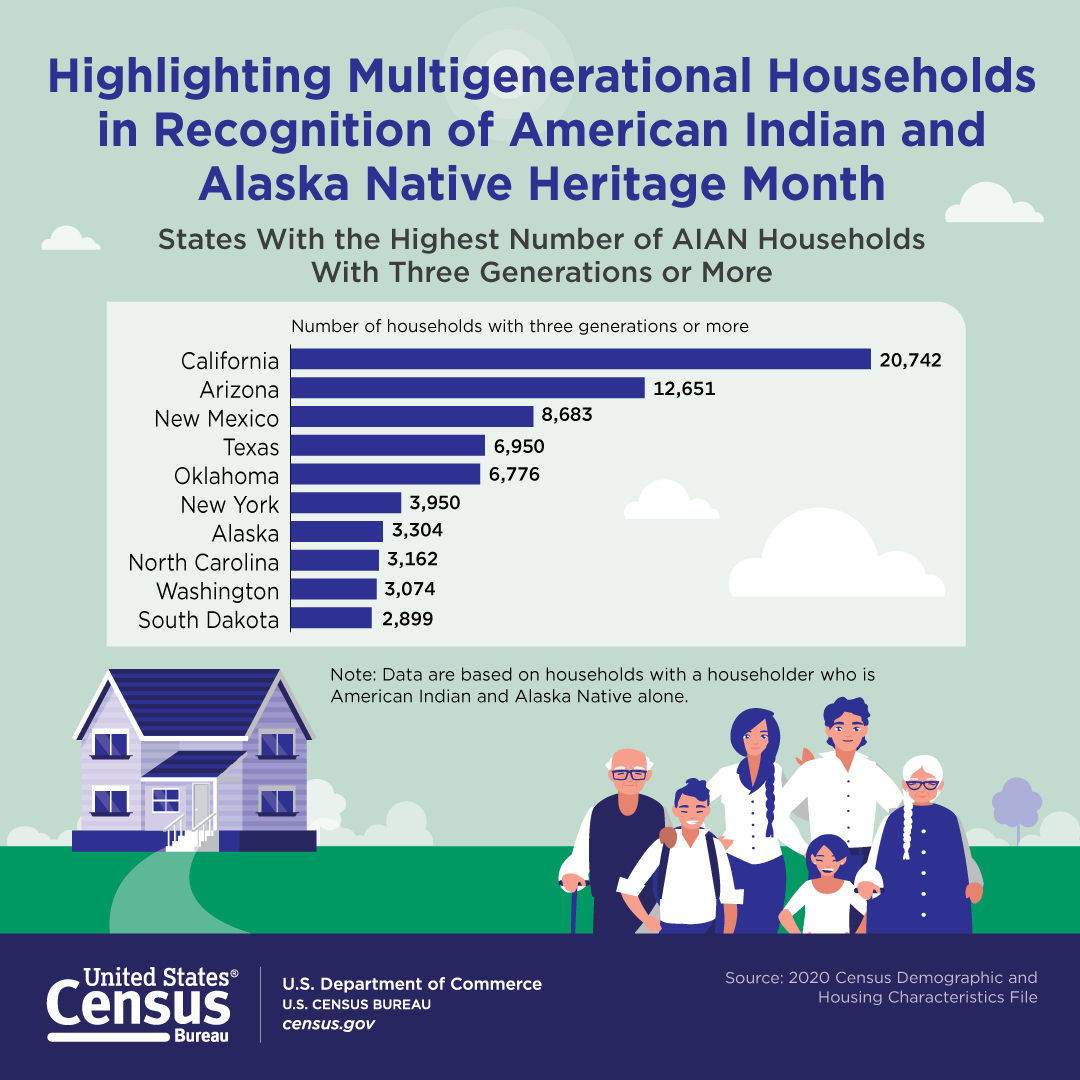Facts for Features: American Indian and Alaska Native Heritage Month: November 2023
The first American Indian Day was celebrated in May 1916 in New York. The event culminated an effort by Red Fox James, a member of the Blackfeet Nation, who rode across the nation on horseback seeking approval from 24 state governments to have a day to honor American Indians. In 1990, more than seven decades later, then-President George H.W. Bush signed a joint congressional resolution designating the month of November “National American Indian Heritage Month.” Similar proclamations have been issued every year since 1994 to recognize what is now called “American Indian and Alaska Native Heritage Month.” This Facts for Features presents statistics for the American Indian and Alaska Native population, one of the six major race categories defined by the U.S. Office of Management and Budget.
The following facts are possible thanks to responses to the U.S. Census Bureau’s surveys. We appreciate the public’s cooperation as we continuously measure America’s people, places and economy.
Did You Know?
1.5 million
The number of people who identified as Cherokee in the 2020 Census. Cherokee was the largest American Indian alone or in any combination population group in the United States in 2020. The Navajo Nation was the most common American Indian alone response with 315,086 people.
Source:
9,026
The number of people who identified as Yup’ik (Yup'ik Eskimo) in the 2020 Census. Yup’ik (Yup'ik Eskimo) was the largest Alaska Native alone group in the United States. Tlingit was the largest Alaska Native alone or in any combination group with 22,601 people.
Source:
9.7 million
The nation's American Indian and Alaska Native population alone or in combination in 2020.
Source:
324
The number of distinct, federally recognized American Indian reservations in 2022, including federal reservations and off-reservation trust lands.
Source:
221
The number of Alaska Native village statistical areas.
Source:
574
The number of federally recognized Indian tribes in 2023.
Source:
122,579
The number of single-race American Indian and Alaska Native veterans of the U.S. armed forces in 2022.
Source:
More Stats
A detailed profile of the American Indian and Alaska Native population alone or in combination with one or more other races is available from 2020 Census and the 2022 American Community Survey. Statistics include:
- Families.
- Housing.
- Languages.
- Education.
- Jobs.
- Income and poverty.
- Health insurance.
Wall Maps
- American Indians and Alaska Natives in the United States
- American Indians and Alaska Natives in Alaska
Related News Products
- My Tribal Area Data Tool
- 2020 Census Detailed Demographic and Housing Characteristics File A (step-by-step videos and instructions)
Previous Facts for Features
- FFF: American Indian and Alaska Native Heritage Month: 2022
- FFF: American Indian and Alaska Native Heritage Month: 2021
- FFF: American Indian and Alaska Native Heritage Month: 2020
- FFF: American Indian and Alaska Native Heritage Month: 2019
- FFF: American Indian and Alaska Native Heritage Month: 2018
- FFF: American Indian and Alaska Native Heritage Month: 2017
Stats for Stories
Statistics in Schools
Previous Graphics
Observances in our Facts for Features series:
- National Black History Month (February)
- Women's History Month (March)
- Irish-American Heritage Month (March)
- Asian American and Pacific Islander Heritage Month (May)
- The Fourth of July
- Anniversary of Americans With Disabilities Act (July 26)
- National Hispanic Heritage Month (Sept. 15 – Oct. 15)
- Halloween (Oct. 31)
- National Native American Heritage Month (November)
- Veterans Day (Nov. 11)
- Holiday Season (November — December)
Editor’s note: These data come from a variety of sources and may be subject to sampling variability and other sources of error. We generally release Facts for Features about two months before observances to accommodate magazine production timelines. For more information, contact the Census Bureau’s Public Information Office at (301)763-3030 or <[email protected]>.
Profile America's Facts for Features provides statistics related to observances and holidays not covered by Stats for Stories. For observances not listed above, visit our Stats for Stories webpage.
Stats for Stories provides links to timely story ideas highlighting newsworthy Census Bureau statistics that relate to current events, observances, holidays and anniversaries. The story ideas are intended to assist the media in story mining and producing content for their audiences. Dates with presidential proclamations are marked with (P).







